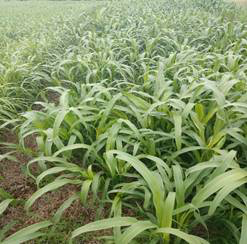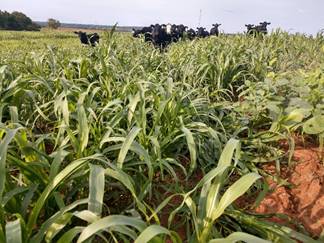Cow-Calf Corner | August 1, 2022
Drought Weighing on Summer Cattle Markets
Derrell S. Peel, Oklahoma State University Extension Livestock Marketing Specialist
Drought advanced rapidly across Oklahoma in July. At the end of June, the Drought Monitor showed that 30.76 percent of the state was in some stage of drought (D1-D4) with another 15.15 percent abnormally dry (D0). Four weeks later, the July 26 Drought Monitor map showed that 100 percent of the state was dry with 99.81 percent in some stage of drought. In fact, 92.11 percent of the state was Severe drought (D2) or worse. The northern one-third of Oklahoma received good rains of up to three inches in the last week. This will briefly push back drought conditions in that region, but triple digit temperatures are forecast to return in August and little follow-up rain is in the forecast as far as forecasts reach into the first half of August. Cattle producers will continue to face tough decisions in the coming weeks.
Rapidly advancing drought conditions in July pushed Oklahoma auction volumes higher as more cows were culled and increased feeder cattle numbers indicated early weaning of calves and early marketings of summer grazing cattle. Calf prices dropped into July as increased volumes of early weaned calves accelerated seasonal price pressure. Calf prices recovered somewhat the last week of July as cattle markets generally firmed up. Large seasonal supplies of heavy feeder cattle were also likely augmented by drought-forced movement of cattle off summer grazing programs though heavy feeder prices are seasonally higher through the summer.
The July volume of slaughter cows and bulls was more than double last year in Oklahoma auctions. The cull cow market was overwhelmed with prices sharply lower. In Oklahoma City, boning cow prices decreased from $89.51/cwt. the last week of June to an average of $66.70/cwt. the last two weeks of July. Around the region, boning cow prices were similarly lower from Kansas south through Texas. Cull cow prices generally decreased around the country in July with the sharpest decreases in the central and southern plains. In some markets, cull cow prices recovered slightly the last week of July.
Nationally, beef cow slaughter continued a double-digit pace in July. Beef cow slaughter through mid-July is up 14.1 percent year over year for the year to date. Year over year percent increases in beef cow slaughter may be smaller in the last part of year (compared to increased slaughter last year). However, beef cow slaughter would have to drop to a level less than six percent higher year over year for the remainder of the year before the annual beef cow slaughter would not be double-digit higher for the entire year. Heifer slaughter, which represents decisions several months ago about reduced heifer retention, is up 3.9 percent year over year so far this year. The July 1 inventory of heifers in feedlots was up 2.9 percent over last year and confirms that heifers continue to be diverted into feeder channels rather being retained for breeding. The mid-year cattle inventory showed that the beef cow herd was down 2.4 percent year over year and the inventory of beef replacement heifers was down 3.5 percent from last year. The beef industry is poised to see the largest single year beef cow herd decrease in more than 35 years.
Beef Cow Culling Criteria
Mark Z. Johnson, Oklahoma State University Extension Beef Cattle Breeding Specialist
As we continue to deal with drought and extreme heat, pasture conditions across Oklahoma are deteriorating rapidly. Low hay inventories and high feed cost are forcing cow-calf operation to make some hard decisions. Reducing your cow inventory may be the best option to reduce stress on your grazing system and help stretch your feed/forage resources as long as possible. If you find yourself in this situation right now, consider the following culling criterion.
- Open cows/pregnancy status. From our recent peak inventory in 2018, our national beef cow inventory has decreased by over 6% as of July, 2022. This has been dramatically accelerated by drought in various parts of the U.S. over the past two years. This is the light at the end of the tunnel with respect to the future value of beef calves. Fewer cows in production = fewer calves produced = cycle to higher value for calves. As we cull cows in order to persevere and sustain our cow-calf business operation, I would prioritize holding onto heavy bred cows over short bred cows and cull the opens.
- Cull old cows/keep your young cows. Cows reach their prime production years at about 4 years of age, and around 10 years of age most cows start to wean smaller calves, are more likely to come up open and have health issues.
- Cull on bad disposition. Waspy, aggressive cows that are hard to catch and work. If you have made excuses for keeping them in the past, the current situation is the perfect reason to cull.
- Non-conforming/unsound. Late to breed and calve (see reason number 1), bad feet, bad legs, bad udders, bad
eyes, bad teeth, doesn’t shed hair and can’t handle summer heat? Bad health history?
Now is the time to get them off the feed bill.
Finally, if all your cows are bred, due to calve within a 30-day window, have a calm temperament, perfect udders, feet and legs, are 4 years old, etc. …and you must reduce inventory, take a look at cow production records. Checking pregnancy status, weighing calves and cows each year at weaning has several long-term benefits. Your best cows wean off the highest percentage of their mature weight each year. These more productive cows are those that combine the genetic potential to conceive/calve early in the season, avoid health issues and have appropriate mature weight and milk potential relative their production environment. For example, if you look at past production records and find that your cow herd averages weaning off 45% of their mature weigh with a range of 35% - 55%. You have determined that you need to cull half of your cows, you should cull the lower producing half that have averaged weaning off less than 45% of their mature weight. Doing so immediately slashes your feed bill and you still own your best cows.
Late Summer Rains Provide Opportunity to Plant Warm-Season Annuals
Paul Beck, Oklahoma State University State Extension Beef Nutrition Specialist
Drought has impacted pasture forage production and hay yields across the region. Many producers are faced with the choice between selling cows now or feeding up their already limited hay supply early. Late last week areas across North Texas, Northern Oklahoma and into Kansas and the Mid-South got nice rains which can rejuvenate drought-stricken pastures and provide some relief from pressure to start feeding hay. This rain also provides the opportunity to plant warm-season annuals into crop fields for fall pasture.
Warm-season annuals are often thought of as emergency grazing and hay crops when late spring and early summer hay harvests are lacking. Annual forage crops such as millets, sudangrass and sorghum-sudangrass hybrids or legumes like cow peas or mung beans are usually planted in the late spring or early summer for mid to late summer harvest. Recent research has investigated using annual forages in novel ways to further extend grazing seasons. In the Southeast and Southern Great Plains, late summer plantings of warm-season annuals have been used to fill the gaps in fall forage production.
Annual grasses including sorghum/sudangrass, Pearl millet, browntop millet, and corn were planted in late August of 2018, when these were harvested in October 42 days later yields ranged from 2,500 pounds of dry matter per acre for browntop millet and a VNS corn to over 3,300 pounds of dry matter per acre for sorghum/sudangrass, Pearl millet, and a brown midrib grazing corn variety. These forages were 16 to 18% crude protein and 60 to 65% total digestible nutrients at harvest in October. Following a frost in late November, these forages were still 12 to 15% crude protein and 61 to 65% TDN for all but browntop millet that was only 51% TDN.
Grazing of millets, sudangrass, and sorghums should be withheld until they are 18 to 36 inches tall and rotations should be timed to leave 6 to 8 inches of stubble height to enhance regrowth potential. Grazing can occur as early as 4 weeks post planting, but their rapid growth makes ideal management challenging.
Steers grazing millet and a cover crop forage blend in the late summer and fall gained over 2 pounds per day in tests in Central Oklahoma, showing these forages can be an option for high quality pasture in the gap between summer grass and fall wheat pasture.
These pastures were planted the first of August and were grazed starting on September 11, 40-days after planting.


This year high feed and grain prices limit our ability to feed our way out of a drought. Annual forages offer many advantages in designing systems to extend grazing seasons in all environments. Annual forages are generally higher in nutritive value than perennials and plantings can be timed to fill gaps in availability of the dominant perennial forages in the local environment.
